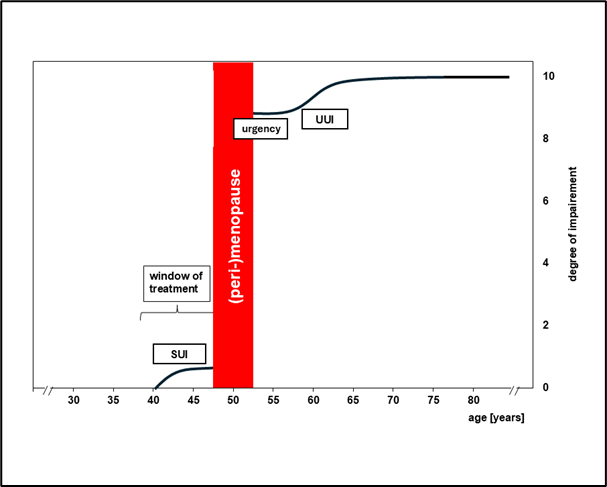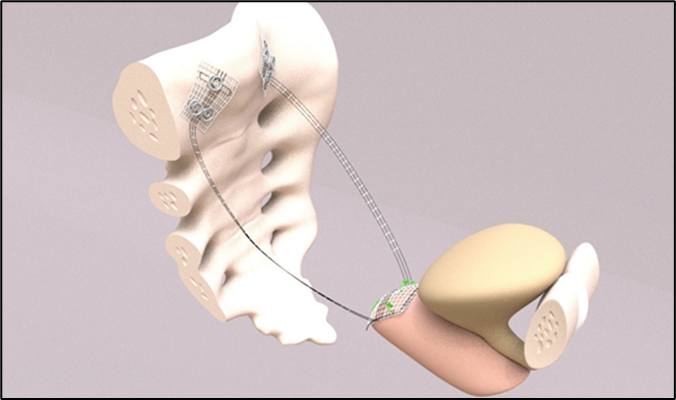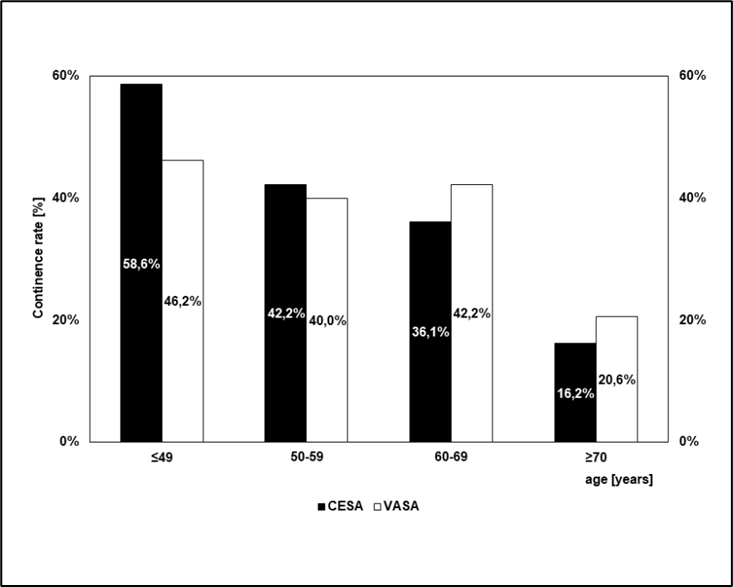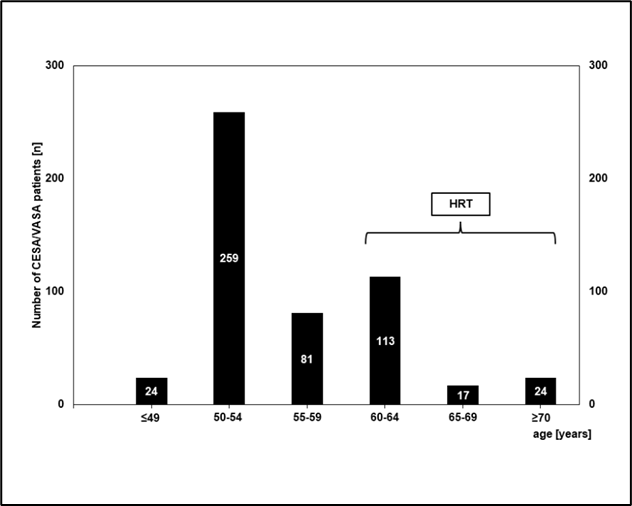AUCTORES
Globalize your Research
Research Article | DOI: https://doi.org/10.31579/2578-8965/265
1 Department of Gynecology and Obstetrics, University Hospital Cologne, Germany.
2 Institute of Medical Statistics and Bioinformatics, University of Köln, Germany.
*Corresponding Author: Wolfram Jäger, Department of Gynecology and Obstetrics, University Hospital Cologne, Germany.
Citation: Wolfram Jäger, Nami Jamshidian, Andre Päffgen, Anna Hagemeier, Peter Mallmann, (2025), Urgency Urinary Incontinence Is a Consequence of The Decline in Estrogen Levels After Menopause, J. Obstetrics Gynecology and Reproductive Sciences, 9(3) DOI:10.31579/2578-8965/265
Copyright: © 2025, Wolfram Jäger. This is an open-access article distributed under the terms of The Creative Commons Attribution License, which permits unrestricted use, distribution, and reproduction in any medium, provided the original author and source are credited.
Received: 10 April 2025 | Accepted: 18 April 2025 | Published: 25 April 2025
Keywords: urgency urinary incontinence; OAB; CESA; VASA; hypo-estrogenic tissue remodeling; hormone replacement therapy
Background: Urinary incontinence is a chronically progredient condition that usually begins around in the early forties of life with urine leakage through coughing or sneezing (stress urinary incontinence, SUI). Several years later the patients realize that after the feeling of urge to void they may lose urine when waiting too long (urgency incontinence, UUI). In the beginning of UUI patients can still reach the toilet “dry” if they go immediately after the urge to void, however, within few years the time intervals shorten until loss of urine becomes uncontrollable. That has significant impact on the quality of private and social life.
The etiology of UUI is unknown. Therefore, there is no specific therapy for UUI and current treatments are aimed to reduce symptoms.
However, previous studies have shown that these patients with UUI could regain continence by the surgical tensioning and elevation of the vagina and the attached trigone of the bladder. That effect was achieved by the replacement of the uterosacral ligaments (USL) by laCESA or laVASA. An additional suburethral tape led to overall continence rates (CR) between 67% and 87% in these patients. Multivariate analyses revealed that the difference in the continence rates (CR) after laCESA and laVASA was dependent on the age of patients at surgery. Patients younger than 60 years had significantly higher CR than the older patients. The CR after a TOT; however, was independent of the age at surgery.
It has been hypothesized that this development of incontinence is caused by declining estrogen levels already before and after menopause. Therefore, this study was aimed to test the hypothesis that the increasing urinary incontinence from SUI to UUI was associated with menopause and the time interval after menopause.
Material and Methods: All patients were suffering from UUI. The diagnosis and the age at menopause were evaluated in the context of personal interviews. In all patients with UUI, the vagina was elevated and tightened in the longitudinal axis laparoscopically by substituting the uterosacral ligaments (USL) with PVDF-structures of defined length (laCESA, laVASA). If that did not lead to continence, a suburethral tape (TOT 8/4) was inserted some months later.
Results: Between 2010 and 2022, 326 patients with UUI underwent the surgical treatment. After previous SUI they had developed UUI after menopause. Patients who got estrogen or estrogen/gestagen combinations before menopause became incontinent after they had discontinued their hormonal treatment.
In total, between 56% and 87% of the patients became continent after surgery. The CR after tensioning the vagina by laCESA/laVASA were between 46% and 58% in 50-year-old patients decreasing to 16% and 20% in patients older than 70years. An additional TOT 8/4 led to continence in between 43% and 40% of the still incontinent patients irrespective of their age.
Conclusions: In all patients’ urinary incontinence started premenopausally as SUI and continued to UUI after estrogen deprivation, usually after menopause. This continuous worsening of UUI during the years after menopause was probably caused by the estrogen deficiency.
Since the USL, the vagina and the trigone of the bladder express estrogen receptors their physiological function is dependent or influenced by estrogen. Declining estrogen levels lead to a hypo-estrogenic loss of elasticity leading to laxity, particularly in the utero-sacral ligaments (USL) the vagina and the adherent trigone of the bladder. The decreasing CR of laCESA/laVASA with increasing age must be interpreted as a consequence of the loss of elasticity caused by the longer duration of estrogen deficiency especially in the trigone of the bladder. That supported the hypothesis of the NAMS and the ISWSSH that urgency urinary incontinence (UUI) is caused by estrogen deficiency. Patients with perimenopausal estrogen supplementation (HRT) only became incontinent when they stopped HRT. That observation suggested that early and continuous estrogen therapy may delay or even prevent urinary incontinence. As UI turned out to be an endocrine disorder the optimal estrogen, dosage, mode of application and the onset and duration of estrogen therapy should be investigated and defined by gynecological endocrinologists probably in co-operation with urogynecologists in the future.
| CR: | continence rate (percentage of all patients) | laVASA: | laparoscopic vagina-sacropexy |
| GSM: | “genito-urinary syndrome of menopause" | MUI: | stress and urgency (mixed) urinary incontinence |
| HRT: | hormone replacement therapy | NAMS: | North American Society of Menopause |
| ISWSSH: | International Society for the Study of Women’s Sexual Health | OAB: | overactive bladder (synonym for UUI) |
| laCESA: | laparoscopic cervico-sacropexy | PVDF: | polyvinylidene fluoride |
| laVASA: | laparoscopic vagina-sacropexy | PUL | pubo-urethral ligament |
| CR: | continence rate (percentage of all patients) | SUI: | stress urinary incontinence |
| GSM: | “genito-urinary syndrome of menopause" | TOT: | trans-obturator taped |
| HRT: | hormone replacement therapy | UI: | urinary incontinence |
| ISWSSH: | International Society for the Study of Women’s Sexual Health | UUI: | urgency urinary incontinence (UUI) |
| laCESA: | laparoscopic cervico-sacropexy | USL: | uterosacral ligament |
Urinary incontinence (UI) usually begins around in the early forties of life with urine leakage through coughing or sneezing (stress urinary incontinence, SUI). Most patients find this situation less annoying, as it happens seldom and the use of a simple slip pad suffices to maintain participation in social and private life without restrictions. (Figure 1).

Figure 1: Subjective assessment of private and social limitations caused by different forms of incontinence according to patients’ age. (SUI: stress urinary incontinence; urgency: urgency without urine loss, UUI: urgency urinary incontinence) (The curve corresponds to the degree of limitation of the respective form of urinary incontinence: 0 = no limitation; 10 = maximum limitation)
Several years later the patients realize that if they wait too long after the feeling of urge to void, they may lose urine before reaching the toilet (urgency urinary incontinence, UUI).
Urgency urinary incontinence (UUI), however, imposes substantial limitations on both social and private activities. Initially, patients who experience the urge of a full bladder make the experience that they can still delay voiding and complete their current activities without fear of uncontrolled urine loss. However, within a few years, the time interval between the urge to void and loss of urine shortens and reaches the point when urine loss becomes completely uncontrolled [1, 2].
This uncontrollable loss of urine has significant impact on the quality of private and social life. This development is a severe experience for the affected women. Personal freedom to do what they want in public and private life is suddenly restricted by the bladder [3]. (Figure 1).
The etiology of urinary incontinence and the conditions underlying the transition from SUI to UUI are unknown. Historically, these two conditions were thought to have different etiologies. However, the chronological order of symptoms starting from SUI developing to UUI and finally to total incontinence in all patients indicate that these different forms of UI may have a common etiology. Furthermore, the chronological occurrence of the symptoms at defined decades of life indicated that the etiology of urinary incontinence is caused or associated with common biological processes at these ages.
The surveys of the North American Society of Menopause (NAMS) and the International Society for the Study of Women’s Sexual Health (ISSWSH) revealed that urgency and urgency urinary incontinence (UUI) typically begin after menopause. This association was so close that the NAMS and the ISSWSH have included "urgency" and "urgency urinary incontinence" in the syndrome "genito-urinary syndrome of menopause" (GSM) [4-6].
They assume that both symptoms of incontinence can be attributed to the decline of estrogens after menopause and are therefore a predominant endocrine disorder and not an urological problem [4-6].
Continence or incontinence is determined at the bladder outlet (meatus internus urethrae) which is located in the lower angle of the trigone of the bladder. The trigone of the bladder is the triangle between the two orifices of the ureters and the opening to the urethra (meatus internus). The sphincter urethrae and detrusor vesicae were considered as the crucial muscles for continence [7,8].
Petros demonstrated in the “Integral Theory” that the incontinence during coughing or sneezing (SUI) was not caused by a defective sphincter muscle but by a laxity of the pubo-urethral ligament (PUL) [9]. To increase the counter-pressure normally exerted by the PUL, a tape is placed under the urethra which provides resistance to the meatus urethrae internus during stress. [9]. The suburethral tape is so effective that it has been included in the guidelines for treatment of SUI [10]. However, the reason for this dysfunction leading to SUI and the occurrence in the early fourth decade of life remained unexplained.
As urgency urinary incontinence (UUI) is not dependent of increased abdominal pressure but follows the neurological sensation of an urge to void it was interpreted and treated as a neurological disorder of the detrusor muscle innervation [11-13].
The "urge sensation" (urgency) is triggered by stretch receptors in the bladder wall. In order to reduce the neurological stimulation of the detrusor muscle after urgency different approaches were developed. The pharmacological treatment only reduced the quantity and quality of the symptoms; however, the injection of Onabotulinumtoxin A blocked the detrusor muscle contractions after the stretch and urge sensation but did not lead to a permanent restoration of continence [14-17]. Therefore, significant doubts remained with regard to the neurological etiology of UUI.
A chance observation in operative oncological gynecology demonstrated that even total incontinence as the ultimate expression of UUI could be cured by surgery.
During a posterior exenteration in patients with cervical cancer invading the sigma colon the bladder was preserved. In order to stabilize the bladder suspension, the upper wall of the vagina under the bladder remained inside. For further stabilization of a full bladder the upper (abdominal) end of the vagina was fixed with a mesh to the promontory. During postoperative (cancer) follow-up examinations, patients reported that they had become continent after surgery, whereas they had been completely incontinent before the operation, and no treatment had helped them [18].
The interpretation of that surprising effect on restoring continence after posterior exenteration was that it must have been caused by the surgical tightening and elevation of the vagina. The urethra and the trigone of the bladder are the respective parts of the urinary system which are attached to the vagina and must have been affected. Therefore, the stretching and elevation of the vagina in the longitudinal axis must have increased the closing pressure at the meatus internus. Beside the longitudinal stretching of the trigone the elevation of the vagina took the trigone in a more vertical axis when standing [1] (Figure 2).

Figure 2: Hypothetical assumptions about how the anatomy of the trigonum vesicae and the anterior vaginal wall changes with the descent of the uterosacral ligament (USL) and the anterior vaginal wall with the trigone of the bladder and the area of the meatus internus urethrae (red lines).
Furthermore, the disappearance of urgency and urgency incontinence indicates that the trigone is of substantial importance in that respect. However, it could not be explained why the timespan between first urge to void and controlled micturition returned to normal immediately after surgery.
To offer this new treatment option to other patients with UUI, a new surgical procedure had to be developed which was based on the normal anatomy of the female pelvis. The vagina adheres to the cervix. Therefore, to tighten the vagina, the cervix had to be elevated. Because the cervix is held by the uterosacral ligaments (USL), it was decided to replace the USL by tapes [19-21].
In order not to interfere with “normal” anatomy and physiology it was decided to replace the USL by tapes with the identical length of the biological USL. To evaluate how continence could be achieved in patients with UUI the surgical procedures had to be standardized so that they could be performed identically in every patient.
Therefore, the most important aspects of that development were that only when all patients had the same symptoms of UUI and got the identical treatment the results could be compared between patients and analysed [22].
Due to the uniform dimensions of the bony pelvis in women, it was possible to develop USL PVDF-implants of identical length for all patients (Dynamesh-CESA: 9.3 cm, Dynamesh-VASA: 8.8 cm, Dahlhausen, Köln, Germany) [23]. The fixation points of the implants (structures) on the sacrum and the vagina or cervix were also precisely defined and marked on the structures. [23] Therefore the surgical performance of CESA and VASA (laparoscopical or by laparotomy) will always be identical [23].
The surgeries were developed for patients with a uterus (uterosacropexy, CESA) and already hysterectomized patients (vaginosacropexy, VASA) (Figure 3). In patients with a uterus, the corpus uteri was removed, and the structures were sewn to the physiological attachments at the cervical stump [24]. Since 2016, the abdominal surgeries were performed laparoscopically (laVASA, laCESA) [25, 26].

Figure 3: Schematic representation of the VASA structure in situ. Fixation of the structure to the vaginal stump and the "USL arms" to the promontory. The fixation sides are marked on the structure.
Between 2010 and 2022, 326 patients with UUI underwent surgical treatment. The overall CR after laCESA was 39% and after laVASA 33% [27]. The additional TOT led to continence in between 35% and 45% of the remaining incontinent patients [27]. In order to evaluate the reasons for the different outcome after surgery all relevant clinical data were statistically analysed. The multivariate analyses revealed that the only significant factor for getting continent after laCESA or laVASA was the age of the patients at the time of surgery. The statistical analyses proposed that the medium age at surgery was 60 years to separate patient’s outcome. The CR for patients younger than 60 years was 46% and for the older patients 28%. That difference was statistically significant [27].
The CR of an additional TOT 8/4 was between 40% and 43% - irrespective of the age of the patients [27].
The dependency of age on the outcome of surgical treatment of UUI had never been reported before. This observation supported the hypotheses of the NAMS and the ISSWSH underlying the “genito-urinary syndrome of menopause” (GSM) which stated that urgency and UUI are caused by the deprivation of estrogens after menopause.[4]. Therefore, it was decided that the results of surgery should be re-evaluated according to the time-interval after menopause.
Since 2010 all patients with UUI who failed conservative treatments were operated by laCESA or laVASA in a clinical Phase II study.
The clinical results were controlled in interviews and documented in questionnaires during follow-up examinations. According to the recommendations of the Institute of Medical Statistics the standard questionnaires for urinary incontinence were adopted in the way that every question could be answered by “yes” or “no” or a definitive number [27].
Urgency urinary incontinence (UUI) was defined as the condition when patients could no longer reach the toilet "dry" when experiencing the urge to urinate. Patients reported that upon the feeling of urge, they could not wait for the weather forecast during television news, as they would lose urine before reaching the toilet [27].
Based on the observation that all patients had SUI as the first symptom before UUI and that the etiology of SUI was a lax PUL, all patients should get a TOT.
However, it had already been noticed in a previous Clinical Phase 1 study that several patients, even patients with mixed urinary incontinence (MUI), became continent just after CESA or VASA and did not need a TOT anymore [18]. Therefore, it was decided to begin treatment with the abdominal part (laCESA, laVASA) and add the vaginal part (TOT 8/4) three months later if needed [18, 27-30].
Continence was defined as controlled micturition without any loss of urine irrespective of the time interval after the urgency sensation.
All patients were asked to determine the age at which they experienced the uncontrolled loss of urine for the first time (SUI) and when they realized that they lost urine short after the urgency sensation (UUI).
Besides the usual clinical examinations, the patients were also examined vaginally in standing position, because they were not incontinent in lying position. Examinations with a full bladder could not be performed therefore all data of the examinations were obtained in patients with a “not-maximally-filled” bladder.
The incontinence-questionnaire were explained to them and the answers documented. Beside the questions about losing urine under stress (coughing, sneezing getting up from sitting, walking) patients were also asked what they would do when they feel the urge to void during TV-news. Could they wait until the weather forecast or did they need to go immediately? Did they reach the toilet “dry” or did they lose urine on the way. The latter answer was an indication for UUI.
Additionally, to these urogynecological questions patients were asked about her age at menopause. Patients who were hysterectomized before menopause were asked about the age when they experienced hot flashes. They were further asked whether they had got peri- or postmenopausal hormone replacement therapy (HRT) and for how long.
Additionally, patients were interviewed about their family history of incontinence, especially about her mother.
All these data were recorded in a computer program at the day when they came to the clinic for the first time and during follow-up.
This study was focused on the descriptive analyses of the target variable “continence” as well as of the influencing variables “age at surgery”, “time-interval to menopause” and “kind of surgery (CESA or VASA)”. Age at surgery was subdivided in the timespans after menopause in patients unconnected samples.
To test significant differences of the categorial variables the Χ² test was applied for univariate analysis of significance. If the sample size (n) was applied Fisher´s exact test was applied. The level of significance α was defined at 0.05 therefore p<0>
For calculations the IBM SPSS Statistics Program (version 26) was used. All calculations were performed at the Institute for Medical Statistics and Bioinformatics, University of Köln, Germany [27].
The Clinical Trial was approved by the Scientific Committee of the University of Köln and the Ethic Committee of the University of Köln (approval number: TN 20-1267). The current analysis was approved on June 29th, 2022 (nr.20-2312) [27].
During the observation period 326 patients with UUI fulfilled the study criteria [27,29,30]. Since all patients of the study were postmenopausal the CR were analysed according to the time interval after menopause.
Incontinence began between the ages of 40 and 45 with urine loss during coughing and sneezing ("stress incontinence", SUI). Most patients experienced menopause at the age of 50 years. 24 patients were between 40 and 49 years. They became amenorrhoeic after chemotherapy for cancer treatment or surgical removal of the ovaries for different indications (endometriosis, ovarian cysts, family history of ovarian cancer).
After cessation of ovarian function, patients made the experience that after the urge to void they sometimes lost urine before reaching the toilet. After about 2 to 4 years, they experienced urine loss already upon standing up from a chair or on the way to the toilet. They never lost urine when sitting on the chair.
Overall, between 72% (laVASA) and 87% (laCESA) of patients under 60 years of age regained continence by the replacement of the USL and a suburethral tape (TOT 8/4).
In older patients (older than 60 years at surgery) continence rates (CR) ranged between 56% and 63% [27].
In the multivariate analysis patients´ age at surgery was the only factor with significant influence on the CR [27].
The proportion of patients who regained continence solely through elevation and tensioning of the vagina via laCESA or laVASA decreased significantly with increasing time since menopause (or stop of ovarian function). While between 46% and 58% of younger patients became continent, the corresponding proportion in older patients was between 16% and 20% (p<0.001) (Figure 4)

Figure 4: Continence rates after CESA or VASA depending on the age at the time of surgery.

Figure 5: Distribution of estradiol receptors (ER) in the pelvis. ERs are primarily located in the uterosacral ligament, vaginal wall, endo-and myometrium, urethra, and trigonum vesicae.

Figure 6: Age at which patients developed urge incontinence. The total number of patients in each age group is indicated in the respective columns.
Patient groups that received HRT are indicated by the bracket. (For this analysis, data from patients who received both a CESA or VASA and a TOT were also included in accordance with the study objective.)
The CR after the transobturator tape (TOT 8/4) was independent of patients’ age at surgery [27].
97% of patients reported that their mother also had UUI. As far as they knew that was probably at the same age when their own incontinence began.
The results of the Phase II study confirmed the observation of NAMS and ISSWSH that UUI is a disorder of menopause. All patients had experienced SUI as the first symptoms of UI.
That always started in their forties, however, the first symptoms of UUI appeared after menopause. The NAMS and the ISSWSH assumed that UUI is caused by the estrogen deficiency after menopause. Considering this hypothesis SUI and UUI are not two different etiological entities but probably the result of a continuous development (“pathophysiological continuum”).
The beginning of SUI in the forties of the patients does not necessarily disprove the estrogen dependency theory of UI. Urinary incontinence is a typical symptom of the premenstrual syndrome [31]. Incontinence in these women is definitively explained by hormonal changes during the menstrual cycle especially during the luteal phase of the cycle [31]
That gives a hint that urinary incontinence is not a urological disorder but a consequence of hormone imbalance. [4,5,31,32]
In principle, UUI could be cured by the replacement of the USL by laCESA or laVASA sometimes in addition with the replacement of the PUL by a suburethral tape (TOT 8/4).
The surgical elevation and tensioning of the vagina by laCESA or laVASA probably leads to the compression of the meatus [27]. However, the number of patients who regained continence after laCESA or laVASA decreased significantly with increasing age after menopause. That age dependency of CR was not observed after the suburethral tape (TOT 8/4).
Since the PVDF-USL structures (Dynamesh CESA/Dynamesh VASA) all had the same length and were always sutured to the same defined anatomical sides the differences in continence rates after laCESA or laVASA, e.g., between 50-years-old and 70-year-old patients, must have been due to structural changes of the vagina or the trigone of the bladder (or both).
The probable effects of estrogen deficiency on the urethra were not evaluated.
The continence restoring effects of a TOT 8/4, however, were independent of age after menopause. That was reasonable, considering that the TOT replaced the function of the PUL. However, if UI is based on estrogen deficiency than SUI should also have the same etiology. Since the Integral Theory has demonstrated that SUI is caused by a lax PUL it seems reasonable to assume that the PUL and the lower trigone are (one of) the first structures affected by estrogen deficiency [9]
While a suburethral tape can cure SUI, this method alone is not capable of curing UUI. Considering the 17% CR in 70-year-old patients after laCESA or laVASA, but the additional 40% of patients who became continent at this age following the TOT, a clinical Phase I study was started in patients older than 70 years with UUI with the initial placement of the TOT 8/4. However, that study had to be discontinued after 10 patients, as none of the older patients became continent after the TOT alone. This observation strongly indicates that the effect of the suburethral tape is restricted to the area below the meatus internus. It demonstrated that UUI is a problem of the trigone including the meatus internus which are not directly touched by a TOT. The results implicate that a suburethral tape (e.g. TOT) can probably only be effective for treatment of SUI as long as the trigone and the vagina are not submitted to the hypoestrogenic tissue remodelling.
Therefore, urgency and the accompanying incontinence must be triggered in the area of the trigone and the adherent vaginal wall. The beginning of UUI after menopause implicates that the decline of estrogens must affect these structures. Immunohistochemical studies supported that assumption. It has been shown that estrogen receptors (ER) are expressed in the uterus, the endometrium, the USL and the vaginal epithelium. Beside these structures, however, ER were also found in the trigone of the bladder and in the epithelial lining of the urethra [33-35] (Figure 5).
ER in these anatomical structures indicate that estrogens must be important for the physiological function of these structures [36].
It is probably the ability of estrogens to form elastic hyaline structures. Elasticity is the ability to stretch and to contract. That elasticity is of crucial importance for the uterus, the USL and the vagina during pregnancy. [4,5,37].
Beside the increase in uterine size during pregnancy the USL must increase their elasticity in order to let the cervix descend in the pelvis. Extremely important is the increasing elasticity of the vagina. The elastic capacity of the vagina is enormous considering that until delivery the circumference of the vagina must stretch to approximately 38 cm (97 inches) for the passage of the child [38]. When the child during birth reaches the lower vagina where the bladder trigone is adherent, not only the vaginal wall must stretch but also the trigone of the bladder in order to prevent tearing of the bladder during the passage of the child's head. Finally, the urethra must also be able to stretch longitudinally during the child's exit out of the birth canal.
During pregnancy, parallel to the child´s growth the concentrations of estrogens increase massively [35]. These increasing amounts of estrogen needed for uterine growth and the other mentioned anatomical structures until birth cannot be produced by the ovaries and therefore becomes a significant task of the placenta. The increase in estrogen levels during pregnancy, particularly in the last trimester, supports the assumption that estrogens are crucial for the aforementioned increase in tissue elasticity [39, 40].
During the puerperal phase all these structures have to return to their normal size and elasticity.
This phase is accompanied by decreasing estrogen levels after removal of the placenta until the elasticity returns to normal.
It can be assumed that the declining levels of estrogens around or after menopause will lead to a loss of elasticity in all of these estrogen-sensitive tissues. This can lead to a reduced tension of the tissues (laxity) or a shrinkage. These effects of estrogen deprivation are established knowledge in vulvovaginal atrophy as well as in pelvic organ prolapse but only recently the decline of estrogens was associated with the development of urinary incontinence [3-5]. With the increasing period of estrogen deficiency after menopause the elasticity of the trigone will continuously decrease leading to a laxity of the trigone which does not allow further stretching when the bladder fills. Therefore, the time interval between the sensation of urgency and urine discharge also shortens continuously. The additional effect of the laxity of the USL will lead to a reduced suspension of the vagina bringing the meatus internus in a more horizontal axis especially when standing up in an upright position. [Figure 2]
Taking into consideration the observations of the study, UUI and probably also SUI – and therefore urinary incontinence - are based on declining estrogen levels. That was at least in part the hypothesis of the NAMS and the ISWSSH [4,5]
That leads to the hypothesis that the laxity of the PUL is also a consequence of decreasing estrogens before menopause. That seems to contradict the estrogen deficiency theory, but urinary incontinence is a classical symptom of the premenopausal syndrome which is definitively caused by hormonal changes [31]
That would offer a hypothesis why SUI usually appears around the forties of life and not at any other time of life.
The exact prevalence of UUI is not known. If the described pathogenesis is correct, UUI would be expected in every woman after menopause. However, only about 30% of women in postmenopause are affected, possibly slightly more assuming some underreporting [3,10, 41,42]. The result of the survey within the study that 97% of patients reported the mother was also incontinent suggests a genetic predisposition. Recent genetic studies support that assumption [42,43].
The decision of the NAMS and ISSWSH to include the symptoms "urgency" and "urgency urinary incontinence" in the Genito-urinary Syndrome of Menopause (GSM) to express that both symptoms of incontinence can be attributed to the decline of estrogens after menopause were fully supported by the results of the study [2, 44-49]. Based on these ideas, treatment should consist of substituting ovarian steroids [50–53]. However, it has not been determined when to start HRT and how long it should be continued.
The first analyses of several studies of "hormone replacement therapy" (HRT) in postmenopausal women, which included information about the incontinence status of patients during HRT contradicted the effectiveness of estrogens to influence urinary incontinence. [53]. These studies demonstrated that UUI cannot be influenced or improved by HRT which suggests that the hypoestrogenic laxity of the trigone is not reversible anymore by hormones after menopause [53]. These patients will need surgical treatment.
Nevertheless, the study provided evidence that such an approach appears sensible and additionally offers a promising perspective. Most patients (67%) developed the urge symptoms between the ages of 50 and 56 (Figure 6). However, 33% of patients developed UUI between the ages of 57 and 60 years. These patients reported being treated perimenopausally with various estrogen preparations due to a "dry vagina" or hot flashes. When they discontinued these treatments for their own reasons (fear of breast cancer) after a few years, UUI occurred shortly thereafter.
An interesting perspective emerged from the 41 patients who developed incontinence around the age of 70 (Figure 6). These patients reported being ovariectomized between the ages of 45 and 50 for various indications. They were given various oral estrogen/progestogen combinations and advised to continue this medication until the age of 65 or 70. When these patients discontinued therapy at the recommended age, they became incontinent within 1 to 2 years.
The observation that patients remained continent as long as they continued estrogen substitution suggests that the onset of incontinence can be delayed or even prevented by substituting ovarian steroids. This substitution should then be lifelong, as incontinence otherwise begins delayed in older age. Treatment should start early, before estrogen deficiency leads to hypoestrogenic tissue remodeling. If urinary incontinence starts to bother the patients a return to continence by estrogens or progestogens is not possible anymore, according to our current knowledge. [46].
There is a familial disposition to incontinence.
It has been shown that urinary incontinence has a familial predisposition [53-55].
The familial predisposition to incontinence is a clinical important observation. This suggests that daughters of a mother with UUI have a significantly increased risk of becoming urgency urinary incontinent after menopause as well. Early substitution of estrogens to prevent incontinence would mean starting at an earlier age in the daughter than the mother became her first symptoms of urinary incontinence (SUI). If such "prophylactic" substitution is rejected by the daughter, this decision should be reconsidered at her first symptoms of SUI (urine loss when coughing). It is then known that the patient is on her way to UUI. Therefore, HRT should be started at that time. If the patient accepts to get a suburethral tape in that situation it would be interesting to evaluate the effects of HRT on further development of continence/incontinence.
Starting HRT when the patient has already developed urgency symptoms (” when I feel I should go – I must go immediately!”) does not improve incontinence as respective HRT studies have shown [54].
Hormonal substitution for the prevention of incontinence has not yet been performed. Based on current observations, estrogens should be used [56,57] The usual aspects of conducting HRT must be considered. Uncertainties remain regarding dosage, the mode of application and ultimately the choice of ovarian steroids. This should be investigated in randomized trials which take several years. In the meantime, until the results of these studies are available, patients should nevertheless be offered a local (vaginal) treatment with estrogens. The biological effects of estrogen treatment can be controlled by vaginal smears during regular patient check-ups [57]. Clinical symptoms of UUI can be documented in simple questions (“what do you do after an urge sensation during the news when you want to see the weather forecast?”).
The prevention of incontinence would be invaluable. A possible "incontinence prophylaxis" would be a new extension of gynecological-endocrinological therapy. Thus, urinary incontinence extends from the reactive-surgical treatment spectrum of gynecology into the preventive-hormonal spectrum of gynecological endocrinology. Several clinical studies will be necessary in the future. Overall, these insights present promising perspectives and tasks for the fields of gynecological urology and especially of gynecological endocrinology in future.
Urinary incontinence (UI) is a genetically predisposed disorder. It follows a symptomatically and chronological sequence starting with stress urinary incontinence (SUI) leading to urgency urinary incontinence (UUI) after menopause.
That pathogenesis is hypothetically caused by the decline of estrogen levels during the pre-, peri- and postmenopausal phases of life. Urinary incontinence is based on the uncontrolled loss of urine through the meatus internus of the bladder. The meatus is the lower angle of the trigone of the bladder, the area between the orifices of the ureters and the meatus internus of the urethra. The trigone is the only part of the bladder which expresses estrogen receptors (ER), indicating that estrogen is needed for the physiological function of the trigone. This physiological function is elasticity in order to stretch that part of the bladder during filling and to contract at the meatus when stress is exerted.
With decreasing estrogen levels, the elasticity diminishes what leads to laxity or shrinkage of the estrogen responsive tissues.
Furthermore, when the bladder fills, the trigone continuously loses its elasticity leading to an ever-shorter interval between urgency and urine loss.
The clinical consequence is uncontrolled loss of urine after the urge sensation (UUI).
UUI can surgically be cured by the standardized replacement of the lax USL by laCESA or laVASA and the replacement of the PUL by a TOT 8/4. However, the continence rates decrease significantly after menopause during each decade thereafter. That indicates that the postmenopausal hypoestrogenic tissue remodelling probably at the trigone cannot be reversed by these surgical procedures anymore.
It was an important observation that patients who had a previous hormone replacement therapy (HRT) starting before menopause developed UUI only when they stopped HRT. Therefore, early estrogen substitution can probably prevent the tissue remodelling leading to UUI.
HRT should start at the same age as SUI started in the mother. HRT should be continued lifelong. The methods of application, preparation, or dosage of the estrogen should be studied in future clinical trials by gynecological endocrinologists.
The authors thank Dr. Ludwig, who, together with Dr. Morgenstern, developed and performed the laparoscopic surgical techniques (laCESA, laVASA). The authors also thank Ms. E. Neumann for data documentation and her always open ears for all the wishes and concerns of the patients.
W. Jäger states that there is no conflict of interest regarding the claims made in the manuscript. He receives licensing fees for the structures.
All our studies had been approved by the Ethics Committee of the University of Köln.
Clearly Auctoresonline and particularly Psychology and Mental Health Care Journal is dedicated to improving health care services for individuals and populations. The editorial boards' ability to efficiently recognize and share the global importance of health literacy with a variety of stakeholders. Auctoresonline publishing platform can be used to facilitate of optimal client-based services and should be added to health care professionals' repertoire of evidence-based health care resources.

Journal of Clinical Cardiology and Cardiovascular Intervention The submission and review process was adequate. However I think that the publication total value should have been enlightened in early fases. Thank you for all.

Journal of Women Health Care and Issues By the present mail, I want to say thank to you and tour colleagues for facilitating my published article. Specially thank you for the peer review process, support from the editorial office. I appreciate positively the quality of your journal.
Journal of Clinical Research and Reports I would be very delighted to submit my testimonial regarding the reviewer board and the editorial office. The reviewer board were accurate and helpful regarding any modifications for my manuscript. And the editorial office were very helpful and supportive in contacting and monitoring with any update and offering help. It was my pleasure to contribute with your promising Journal and I am looking forward for more collaboration.

We would like to thank the Journal of Thoracic Disease and Cardiothoracic Surgery because of the services they provided us for our articles. The peer-review process was done in a very excellent time manner, and the opinions of the reviewers helped us to improve our manuscript further. The editorial office had an outstanding correspondence with us and guided us in many ways. During a hard time of the pandemic that is affecting every one of us tremendously, the editorial office helped us make everything easier for publishing scientific work. Hope for a more scientific relationship with your Journal.

The peer-review process which consisted high quality queries on the paper. I did answer six reviewers’ questions and comments before the paper was accepted. The support from the editorial office is excellent.

Journal of Neuroscience and Neurological Surgery. I had the experience of publishing a research article recently. The whole process was simple from submission to publication. The reviewers made specific and valuable recommendations and corrections that improved the quality of my publication. I strongly recommend this Journal.

Dr. Katarzyna Byczkowska My testimonial covering: "The peer review process is quick and effective. The support from the editorial office is very professional and friendly. Quality of the Clinical Cardiology and Cardiovascular Interventions is scientific and publishes ground-breaking research on cardiology that is useful for other professionals in the field.

Thank you most sincerely, with regard to the support you have given in relation to the reviewing process and the processing of my article entitled "Large Cell Neuroendocrine Carcinoma of The Prostate Gland: A Review and Update" for publication in your esteemed Journal, Journal of Cancer Research and Cellular Therapeutics". The editorial team has been very supportive.

Testimony of Journal of Clinical Otorhinolaryngology: work with your Reviews has been a educational and constructive experience. The editorial office were very helpful and supportive. It was a pleasure to contribute to your Journal.

Dr. Bernard Terkimbi Utoo, I am happy to publish my scientific work in Journal of Women Health Care and Issues (JWHCI). The manuscript submission was seamless and peer review process was top notch. I was amazed that 4 reviewers worked on the manuscript which made it a highly technical, standard and excellent quality paper. I appreciate the format and consideration for the APC as well as the speed of publication. It is my pleasure to continue with this scientific relationship with the esteem JWHCI.

This is an acknowledgment for peer reviewers, editorial board of Journal of Clinical Research and Reports. They show a lot of consideration for us as publishers for our research article “Evaluation of the different factors associated with side effects of COVID-19 vaccination on medical students, Mutah university, Al-Karak, Jordan”, in a very professional and easy way. This journal is one of outstanding medical journal.
Dear Hao Jiang, to Journal of Nutrition and Food Processing We greatly appreciate the efficient, professional and rapid processing of our paper by your team. If there is anything else we should do, please do not hesitate to let us know. On behalf of my co-authors, we would like to express our great appreciation to editor and reviewers.

As an author who has recently published in the journal "Brain and Neurological Disorders". I am delighted to provide a testimonial on the peer review process, editorial office support, and the overall quality of the journal. The peer review process at Brain and Neurological Disorders is rigorous and meticulous, ensuring that only high-quality, evidence-based research is published. The reviewers are experts in their fields, and their comments and suggestions were constructive and helped improve the quality of my manuscript. The review process was timely and efficient, with clear communication from the editorial office at each stage. The support from the editorial office was exceptional throughout the entire process. The editorial staff was responsive, professional, and always willing to help. They provided valuable guidance on formatting, structure, and ethical considerations, making the submission process seamless. Moreover, they kept me informed about the status of my manuscript and provided timely updates, which made the process less stressful. The journal Brain and Neurological Disorders is of the highest quality, with a strong focus on publishing cutting-edge research in the field of neurology. The articles published in this journal are well-researched, rigorously peer-reviewed, and written by experts in the field. The journal maintains high standards, ensuring that readers are provided with the most up-to-date and reliable information on brain and neurological disorders. In conclusion, I had a wonderful experience publishing in Brain and Neurological Disorders. The peer review process was thorough, the editorial office provided exceptional support, and the journal's quality is second to none. I would highly recommend this journal to any researcher working in the field of neurology and brain disorders.

Dear Agrippa Hilda, Journal of Neuroscience and Neurological Surgery, Editorial Coordinator, I trust this message finds you well. I want to extend my appreciation for considering my article for publication in your esteemed journal. I am pleased to provide a testimonial regarding the peer review process and the support received from your editorial office. The peer review process for my paper was carried out in a highly professional and thorough manner. The feedback and comments provided by the authors were constructive and very useful in improving the quality of the manuscript. This rigorous assessment process undoubtedly contributes to the high standards maintained by your journal.

International Journal of Clinical Case Reports and Reviews. I strongly recommend to consider submitting your work to this high-quality journal. The support and availability of the Editorial staff is outstanding and the review process was both efficient and rigorous.

Thank you very much for publishing my Research Article titled “Comparing Treatment Outcome Of Allergic Rhinitis Patients After Using Fluticasone Nasal Spray And Nasal Douching" in the Journal of Clinical Otorhinolaryngology. As Medical Professionals we are immensely benefited from study of various informative Articles and Papers published in this high quality Journal. I look forward to enriching my knowledge by regular study of the Journal and contribute my future work in the field of ENT through the Journal for use by the medical fraternity. The support from the Editorial office was excellent and very prompt. I also welcome the comments received from the readers of my Research Article.

Dear Erica Kelsey, Editorial Coordinator of Cancer Research and Cellular Therapeutics Our team is very satisfied with the processing of our paper by your journal. That was fast, efficient, rigorous, but without unnecessary complications. We appreciated the very short time between the submission of the paper and its publication on line on your site.

I am very glad to say that the peer review process is very successful and fast and support from the Editorial Office. Therefore, I would like to continue our scientific relationship for a long time. And I especially thank you for your kindly attention towards my article. Have a good day!

"We recently published an article entitled “Influence of beta-Cyclodextrins upon the Degradation of Carbofuran Derivatives under Alkaline Conditions" in the Journal of “Pesticides and Biofertilizers” to show that the cyclodextrins protect the carbamates increasing their half-life time in the presence of basic conditions This will be very helpful to understand carbofuran behaviour in the analytical, agro-environmental and food areas. We greatly appreciated the interaction with the editor and the editorial team; we were particularly well accompanied during the course of the revision process, since all various steps towards publication were short and without delay".

I would like to express my gratitude towards you process of article review and submission. I found this to be very fair and expedient. Your follow up has been excellent. I have many publications in national and international journal and your process has been one of the best so far. Keep up the great work.

We are grateful for this opportunity to provide a glowing recommendation to the Journal of Psychiatry and Psychotherapy. We found that the editorial team were very supportive, helpful, kept us abreast of timelines and over all very professional in nature. The peer review process was rigorous, efficient and constructive that really enhanced our article submission. The experience with this journal remains one of our best ever and we look forward to providing future submissions in the near future.

I am very pleased to serve as EBM of the journal, I hope many years of my experience in stem cells can help the journal from one way or another. As we know, stem cells hold great potential for regenerative medicine, which are mostly used to promote the repair response of diseased, dysfunctional or injured tissue using stem cells or their derivatives. I think Stem Cell Research and Therapeutics International is a great platform to publish and share the understanding towards the biology and translational or clinical application of stem cells.

I would like to give my testimony in the support I have got by the peer review process and to support the editorial office where they were of asset to support young author like me to be encouraged to publish their work in your respected journal and globalize and share knowledge across the globe. I really give my great gratitude to your journal and the peer review including the editorial office.

I am delighted to publish our manuscript entitled "A Perspective on Cocaine Induced Stroke - Its Mechanisms and Management" in the Journal of Neuroscience and Neurological Surgery. The peer review process, support from the editorial office, and quality of the journal are excellent. The manuscripts published are of high quality and of excellent scientific value. I recommend this journal very much to colleagues.

Dr.Tania Muñoz, My experience as researcher and author of a review article in The Journal Clinical Cardiology and Interventions has been very enriching and stimulating. The editorial team is excellent, performs its work with absolute responsibility and delivery. They are proactive, dynamic and receptive to all proposals. Supporting at all times the vast universe of authors who choose them as an option for publication. The team of review specialists, members of the editorial board, are brilliant professionals, with remarkable performance in medical research and scientific methodology. Together they form a frontline team that consolidates the JCCI as a magnificent option for the publication and review of high-level medical articles and broad collective interest. I am honored to be able to share my review article and open to receive all your comments.

“The peer review process of JPMHC is quick and effective. Authors are benefited by good and professional reviewers with huge experience in the field of psychology and mental health. The support from the editorial office is very professional. People to contact to are friendly and happy to help and assist any query authors might have. Quality of the Journal is scientific and publishes ground-breaking research on mental health that is useful for other professionals in the field”.

Dear editorial department: On behalf of our team, I hereby certify the reliability and superiority of the International Journal of Clinical Case Reports and Reviews in the peer review process, editorial support, and journal quality. Firstly, the peer review process of the International Journal of Clinical Case Reports and Reviews is rigorous, fair, transparent, fast, and of high quality. The editorial department invites experts from relevant fields as anonymous reviewers to review all submitted manuscripts. These experts have rich academic backgrounds and experience, and can accurately evaluate the academic quality, originality, and suitability of manuscripts. The editorial department is committed to ensuring the rigor of the peer review process, while also making every effort to ensure a fast review cycle to meet the needs of authors and the academic community. Secondly, the editorial team of the International Journal of Clinical Case Reports and Reviews is composed of a group of senior scholars and professionals with rich experience and professional knowledge in related fields. The editorial department is committed to assisting authors in improving their manuscripts, ensuring their academic accuracy, clarity, and completeness. Editors actively collaborate with authors, providing useful suggestions and feedback to promote the improvement and development of the manuscript. We believe that the support of the editorial department is one of the key factors in ensuring the quality of the journal. Finally, the International Journal of Clinical Case Reports and Reviews is renowned for its high- quality articles and strict academic standards. The editorial department is committed to publishing innovative and academically valuable research results to promote the development and progress of related fields. The International Journal of Clinical Case Reports and Reviews is reasonably priced and ensures excellent service and quality ratio, allowing authors to obtain high-level academic publishing opportunities in an affordable manner. I hereby solemnly declare that the International Journal of Clinical Case Reports and Reviews has a high level of credibility and superiority in terms of peer review process, editorial support, reasonable fees, and journal quality. Sincerely, Rui Tao.

Clinical Cardiology and Cardiovascular Interventions I testity the covering of the peer review process, support from the editorial office, and quality of the journal.

Clinical Cardiology and Cardiovascular Interventions, we deeply appreciate the interest shown in our work and its publication. It has been a true pleasure to collaborate with you. The peer review process, as well as the support provided by the editorial office, have been exceptional, and the quality of the journal is very high, which was a determining factor in our decision to publish with you.
The peer reviewers process is quick and effective, the supports from editorial office is excellent, the quality of journal is high. I would like to collabroate with Internatioanl journal of Clinical Case Reports and Reviews journal clinically in the future time.

Clinical Cardiology and Cardiovascular Interventions, I would like to express my sincerest gratitude for the trust placed in our team for the publication in your journal. It has been a true pleasure to collaborate with you on this project. I am pleased to inform you that both the peer review process and the attention from the editorial coordination have been excellent. Your team has worked with dedication and professionalism to ensure that your publication meets the highest standards of quality. We are confident that this collaboration will result in mutual success, and we are eager to see the fruits of this shared effort.

Dear Dr. Jessica Magne, Editorial Coordinator 0f Clinical Cardiology and Cardiovascular Interventions, I hope this message finds you well. I want to express my utmost gratitude for your excellent work and for the dedication and speed in the publication process of my article titled "Navigating Innovation: Qualitative Insights on Using Technology for Health Education in Acute Coronary Syndrome Patients." I am very satisfied with the peer review process, the support from the editorial office, and the quality of the journal. I hope we can maintain our scientific relationship in the long term.
Dear Monica Gissare, - Editorial Coordinator of Nutrition and Food Processing. ¨My testimony with you is truly professional, with a positive response regarding the follow-up of the article and its review, you took into account my qualities and the importance of the topic¨.

Dear Dr. Jessica Magne, Editorial Coordinator 0f Clinical Cardiology and Cardiovascular Interventions, The review process for the article “The Handling of Anti-aggregants and Anticoagulants in the Oncologic Heart Patient Submitted to Surgery” was extremely rigorous and detailed. From the initial submission to the final acceptance, the editorial team at the “Journal of Clinical Cardiology and Cardiovascular Interventions” demonstrated a high level of professionalism and dedication. The reviewers provided constructive and detailed feedback, which was essential for improving the quality of our work. Communication was always clear and efficient, ensuring that all our questions were promptly addressed. The quality of the “Journal of Clinical Cardiology and Cardiovascular Interventions” is undeniable. It is a peer-reviewed, open-access publication dedicated exclusively to disseminating high-quality research in the field of clinical cardiology and cardiovascular interventions. The journal's impact factor is currently under evaluation, and it is indexed in reputable databases, which further reinforces its credibility and relevance in the scientific field. I highly recommend this journal to researchers looking for a reputable platform to publish their studies.

Dear Editorial Coordinator of the Journal of Nutrition and Food Processing! "I would like to thank the Journal of Nutrition and Food Processing for including and publishing my article. The peer review process was very quick, movement and precise. The Editorial Board has done an extremely conscientious job with much help, valuable comments and advices. I find the journal very valuable from a professional point of view, thank you very much for allowing me to be part of it and I would like to participate in the future!”

Dealing with The Journal of Neurology and Neurological Surgery was very smooth and comprehensive. The office staff took time to address my needs and the response from editors and the office was prompt and fair. I certainly hope to publish with this journal again.Their professionalism is apparent and more than satisfactory. Susan Weiner

My Testimonial Covering as fellowing: Lin-Show Chin. The peer reviewers process is quick and effective, the supports from editorial office is excellent, the quality of journal is high. I would like to collabroate with Internatioanl journal of Clinical Case Reports and Reviews.

My experience publishing in Psychology and Mental Health Care was exceptional. The peer review process was rigorous and constructive, with reviewers providing valuable insights that helped enhance the quality of our work. The editorial team was highly supportive and responsive, making the submission process smooth and efficient. The journal's commitment to high standards and academic rigor makes it a respected platform for quality research. I am grateful for the opportunity to publish in such a reputable journal.
My experience publishing in International Journal of Clinical Case Reports and Reviews was exceptional. I Come forth to Provide a Testimonial Covering the Peer Review Process and the editorial office for the Professional and Impartial Evaluation of the Manuscript.

I would like to offer my testimony in the support. I have received through the peer review process and support the editorial office where they are to support young authors like me, encourage them to publish their work in your esteemed journals, and globalize and share knowledge globally. I really appreciate your journal, peer review, and editorial office.
Dear Agrippa Hilda- Editorial Coordinator of Journal of Neuroscience and Neurological Surgery, "The peer review process was very quick and of high quality, which can also be seen in the articles in the journal. The collaboration with the editorial office was very good."

I would like to express my sincere gratitude for the support and efficiency provided by the editorial office throughout the publication process of my article, “Delayed Vulvar Metastases from Rectal Carcinoma: A Case Report.” I greatly appreciate the assistance and guidance I received from your team, which made the entire process smooth and efficient. The peer review process was thorough and constructive, contributing to the overall quality of the final article. I am very grateful for the high level of professionalism and commitment shown by the editorial staff, and I look forward to maintaining a long-term collaboration with the International Journal of Clinical Case Reports and Reviews.
To Dear Erin Aust, I would like to express my heartfelt appreciation for the opportunity to have my work published in this esteemed journal. The entire publication process was smooth and well-organized, and I am extremely satisfied with the final result. The Editorial Team demonstrated the utmost professionalism, providing prompt and insightful feedback throughout the review process. Their clear communication and constructive suggestions were invaluable in enhancing my manuscript, and their meticulous attention to detail and dedication to quality are truly commendable. Additionally, the support from the Editorial Office was exceptional. From the initial submission to the final publication, I was guided through every step of the process with great care and professionalism. The team's responsiveness and assistance made the entire experience both easy and stress-free. I am also deeply impressed by the quality and reputation of the journal. It is an honor to have my research featured in such a respected publication, and I am confident that it will make a meaningful contribution to the field.

"I am grateful for the opportunity of contributing to [International Journal of Clinical Case Reports and Reviews] and for the rigorous review process that enhances the quality of research published in your esteemed journal. I sincerely appreciate the time and effort of your team who have dedicatedly helped me in improvising changes and modifying my manuscript. The insightful comments and constructive feedback provided have been invaluable in refining and strengthening my work".

I thank the ‘Journal of Clinical Research and Reports’ for accepting this article for publication. This is a rigorously peer reviewed journal which is on all major global scientific data bases. I note the review process was prompt, thorough and professionally critical. It gave us an insight into a number of important scientific/statistical issues. The review prompted us to review the relevant literature again and look at the limitations of the study. The peer reviewers were open, clear in the instructions and the editorial team was very prompt in their communication. This journal certainly publishes quality research articles. I would recommend the journal for any future publications.

Dear Jessica Magne, with gratitude for the joint work. Fast process of receiving and processing the submitted scientific materials in “Clinical Cardiology and Cardiovascular Interventions”. High level of competence of the editors with clear and correct recommendations and ideas for enriching the article.

We found the peer review process quick and positive in its input. The support from the editorial officer has been very agile, always with the intention of improving the article and taking into account our subsequent corrections.

My article, titled 'No Way Out of the Smartphone Epidemic Without Considering the Insights of Brain Research,' has been republished in the International Journal of Clinical Case Reports and Reviews. The review process was seamless and professional, with the editors being both friendly and supportive. I am deeply grateful for their efforts.
To Dear Erin Aust – Editorial Coordinator of Journal of General Medicine and Clinical Practice! I declare that I am absolutely satisfied with your work carried out with great competence in following the manuscript during the various stages from its receipt, during the revision process to the final acceptance for publication. Thank Prof. Elvira Farina

Dear Jessica, and the super professional team of the ‘Clinical Cardiology and Cardiovascular Interventions’ I am sincerely grateful to the coordinated work of the journal team for the no problem with the submission of my manuscript: “Cardiometabolic Disorders in A Pregnant Woman with Severe Preeclampsia on the Background of Morbid Obesity (Case Report).” The review process by 5 experts was fast, and the comments were professional, which made it more specific and academic, and the process of publication and presentation of the article was excellent. I recommend that my colleagues publish articles in this journal, and I am interested in further scientific cooperation. Sincerely and best wishes, Dr. Oleg Golyanovskiy.

Dear Ashley Rosa, Editorial Coordinator of the journal - Psychology and Mental Health Care. " The process of obtaining publication of my article in the Psychology and Mental Health Journal was positive in all areas. The peer review process resulted in a number of valuable comments, the editorial process was collaborative and timely, and the quality of this journal has been quickly noticed, resulting in alternative journals contacting me to publish with them." Warm regards, Susan Anne Smith, PhD. Australian Breastfeeding Association.

Dear Jessica Magne, Editorial Coordinator, Clinical Cardiology and Cardiovascular Interventions, Auctores Publishing LLC. I appreciate the journal (JCCI) editorial office support, the entire team leads were always ready to help, not only on technical front but also on thorough process. Also, I should thank dear reviewers’ attention to detail and creative approach to teach me and bring new insights by their comments. Surely, more discussions and introduction of other hemodynamic devices would provide better prevention and management of shock states. Your efforts and dedication in presenting educational materials in this journal are commendable. Best wishes from, Farahnaz Fallahian.
Dear Maria Emerson, Editorial Coordinator, International Journal of Clinical Case Reports and Reviews, Auctores Publishing LLC. I am delighted to have published our manuscript, "Acute Colonic Pseudo-Obstruction (ACPO): A rare but serious complication following caesarean section." I want to thank the editorial team, especially Maria Emerson, for their prompt review of the manuscript, quick responses to queries, and overall support. Yours sincerely Dr. Victor Olagundoye.

Dear Ashley Rosa, Editorial Coordinator, International Journal of Clinical Case Reports and Reviews. Many thanks for publishing this manuscript after I lost confidence the editors were most helpful, more than other journals Best wishes from, Susan Anne Smith, PhD. Australian Breastfeeding Association.

Dear Agrippa Hilda, Editorial Coordinator, Journal of Neuroscience and Neurological Surgery. The entire process including article submission, review, revision, and publication was extremely easy. The journal editor was prompt and helpful, and the reviewers contributed to the quality of the paper. Thank you so much! Eric Nussbaum, MD
Dr Hala Al Shaikh This is to acknowledge that the peer review process for the article ’ A Novel Gnrh1 Gene Mutation in Four Omani Male Siblings, Presentation and Management ’ sent to the International Journal of Clinical Case Reports and Reviews was quick and smooth. The editorial office was prompt with easy communication.

Dear Erin Aust, Editorial Coordinator, Journal of General Medicine and Clinical Practice. We are pleased to share our experience with the “Journal of General Medicine and Clinical Practice”, following the successful publication of our article. The peer review process was thorough and constructive, helping to improve the clarity and quality of the manuscript. We are especially thankful to Ms. Erin Aust, the Editorial Coordinator, for her prompt communication and continuous support throughout the process. Her professionalism ensured a smooth and efficient publication experience. The journal upholds high editorial standards, and we highly recommend it to fellow researchers seeking a credible platform for their work. Best wishes By, Dr. Rakhi Mishra.

Dear Jessica Magne, Editorial Coordinator, Clinical Cardiology and Cardiovascular Interventions, Auctores Publishing LLC. The peer review process of the journal of Clinical Cardiology and Cardiovascular Interventions was excellent and fast, as was the support of the editorial office and the quality of the journal. Kind regards Walter F. Riesen Prof. Dr. Dr. h.c. Walter F. Riesen.

Dear Ashley Rosa, Editorial Coordinator, International Journal of Clinical Case Reports and Reviews, Auctores Publishing LLC. Thank you for publishing our article, Exploring Clozapine's Efficacy in Managing Aggression: A Multiple Single-Case Study in Forensic Psychiatry in the international journal of clinical case reports and reviews. We found the peer review process very professional and efficient. The comments were constructive, and the whole process was efficient. On behalf of the co-authors, I would like to thank you for publishing this article. With regards, Dr. Jelle R. Lettinga.

Dear Clarissa Eric, Editorial Coordinator, Journal of Clinical Case Reports and Studies, I would like to express my deep admiration for the exceptional professionalism demonstrated by your journal. I am thoroughly impressed by the speed of the editorial process, the substantive and insightful reviews, and the meticulous preparation of the manuscript for publication. Additionally, I greatly appreciate the courteous and immediate responses from your editorial office to all my inquiries. Best Regards, Dariusz Ziora

Dear Chrystine Mejia, Editorial Coordinator, Journal of Neurodegeneration and Neurorehabilitation, Auctores Publishing LLC, We would like to thank the editorial team for the smooth and high-quality communication leading up to the publication of our article in the Journal of Neurodegeneration and Neurorehabilitation. The reviewers have extensive knowledge in the field, and their relevant questions helped to add value to our publication. Kind regards, Dr. Ravi Shrivastava.

Dear Clarissa Eric, Editorial Coordinator, Journal of Clinical Case Reports and Studies, Auctores Publishing LLC, USA Office: +1-(302)-520-2644. I would like to express my sincere appreciation for the efficient and professional handling of my case report by the ‘Journal of Clinical Case Reports and Studies’. The peer review process was not only fast but also highly constructive—the reviewers’ comments were clear, relevant, and greatly helped me improve the quality and clarity of my manuscript. I also received excellent support from the editorial office throughout the process. Communication was smooth and timely, and I felt well guided at every stage, from submission to publication. The overall quality and rigor of the journal are truly commendable. I am pleased to have published my work with Journal of Clinical Case Reports and Studies, and I look forward to future opportunities for collaboration. Sincerely, Aline Tollet, UCLouvain.

Dear Ms. Mayra Duenas, Editorial Coordinator, International Journal of Clinical Case Reports and Reviews. “The International Journal of Clinical Case Reports and Reviews represented the “ideal house” to share with the research community a first experience with the use of the Simeox device for speech rehabilitation. High scientific reputation and attractive website communication were first determinants for the selection of this Journal, and the following submission process exceeded expectations: fast but highly professional peer review, great support by the editorial office, elegant graphic layout. Exactly what a dynamic research team - also composed by allied professionals - needs!" From, Chiara Beccaluva, PT - Italy.

Dear Maria Emerson, Editorial Coordinator, we have deeply appreciated the professionalism demonstrated by the International Journal of Clinical Case Reports and Reviews. The reviewers have extensive knowledge of our field and have been very efficient and fast in supporting the process. I am really looking forward to further collaboration. Thanks. Best regards, Dr. Claudio Ligresti
Dear Chrystine Mejia, Editorial Coordinator, Journal of Neurodegeneration and Neurorehabilitation. “The peer review process was efficient and constructive, and the editorial office provided excellent communication and support throughout. The journal ensures scientific rigor and high editorial standards, while also offering a smooth and timely publication process. We sincerely appreciate the work of the editorial team in facilitating the dissemination of innovative approaches such as the Bonori Method.” Best regards, Dr. Matteo Bonori.
